20+ Newspaper Layout Examples to Download
One of the first things most people do to start their day is read the news. This helps the public understand their community a lot better to attain continuous growth.
One of the first things most people do to start their day is read the news. This helps the public understand their community a lot better to attain continuous growth and development. To those behind the ink and pages, designing a newspaper that will cater to the needs of a target audience isn’t the easiest thing in the world.
Development. To those behind the ink and pages, designing a newspaper that will cater to the needs of a target audience isn’t the easiest thing in the world.
Learn how you can make an informative and creative newspaper with the information, design techniques, and newspaper templates provided below.
Parts & Sections of a Newspaper
Although the parts and sections of a newspaper typically vary according to the day of the week, as well as the type and frequency of publication, some of them can be clearly defined as key components of the reading material due to the specific function they play. That being said, let’s take a closer look at the basic parts and sections of a newspaper:
Parts
1. Front Page: Like the cover of a book or magazine, the front page of a newspaper usually carries brief information about what readers will find within its pages. This is the most visible part of the publication which also serves as an introductory letter to its content. You can even find the head, ear, date, slogan, logo design, and other information related to those behind the publication.
2. The Header: This is an essential part of any newspaper. The head, which is located at the top area of the cover page, carries the name, slogan, and logo of the newspaper. This is added for quick and easy identification amidst other leading publications in the field.
3. Ear: You can find the advertisements featured in a newspaper in the ear and ear. This is located at the top and bottom areas of the newspaper’s cover, providing significant information about a business, product, or commercial service.
4. Stripe Strip: This can be found in the bottom or side of the header, specifically where readers are told the date of the newspaper’s publication.
5. Motto and Logo: Every publishing company in the business has a professional logo and a motto to set itself apart from others. Not only can this reinforce your brand message, but this may also strengthen one’s memory of it. These two elements are used to identify the brand of the newspaper and denote its values.
6. Directory and Writing Team: Contrary to those previously mentioned, this part of the newspaper has nothing to do with the publication itself, rather, about the team behind it. This includes personal information and contact details about the company and its editorial and administrative staff. This is everyone from the director, deputy director, and editors to the photographers, illustrators, and graphic artists.
Sections
1. The News Section: A newspaper is a reading material used to deliver the latest news about the world to the public. This is why in the front page of the newspaper you can find a summary of some of the most important stories and events concerning the local community, state, nation, or world. This is usually showcased through compelling news headlines and images to capture a reader’s attention. The news also covers a wide variety of topics including politics, business, and social events.
2. The Opinion Section: This is the part of the newspaper where journalists and writers are given the opportunity to share their opinions on various through different kinds of editorials. In these columns, the articles are intended to persuade readers to think in a certain way or to question the circumstances of a particular situation. Apart from personal letters, editorial cartoons are also used to convey an idea.
3. The Sports Section: Newspapers generally contain information related to sporting events from local and international regions. It may even include youth and college tournaments happening in the community, most especially in the case of small-time newspapers. The coverage of minor and major sporting events has helped widen the publication’s demographics to people from different age groups.
4. The Entertainment Section: If you need a break from the stressful and often frustrating stories of the world, the entertainment section offers you a variety of human interest stories that are discussed from an emotional perspective. Apart from the latest news in pop culture, you can also find information about current film releases, horoscopes, advice columns, comics, and games. Subscription magazines are basically an extension of this section.
5. The Classifieds Section: This refers to a common form of advertising in newspapers where products and services are promoted and offered to readers. Classified ads are similar to short essays in form, where words are used to market goods to buyers and re-sellers alike. Here, boxes and lines are used to emphasize and separate entries within the publication. They are usually categorized according to what is offered, such as car sales, job offers, accounting services, and leases.
10+ Newspaper Layout Templates
Sports Newspaper Template
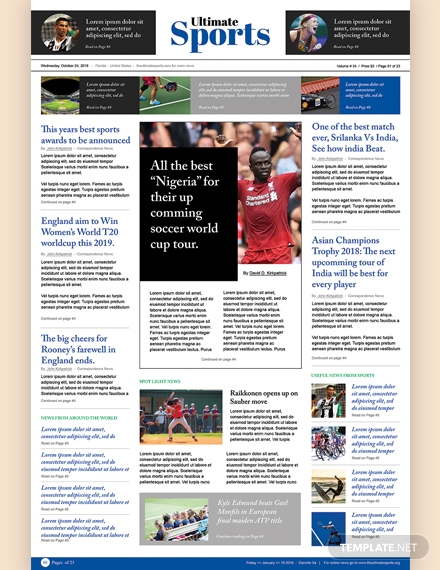
Technology Newspaper Template
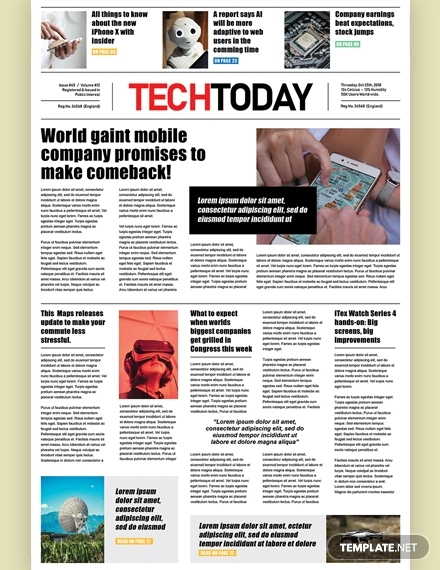
Travel Newspaper
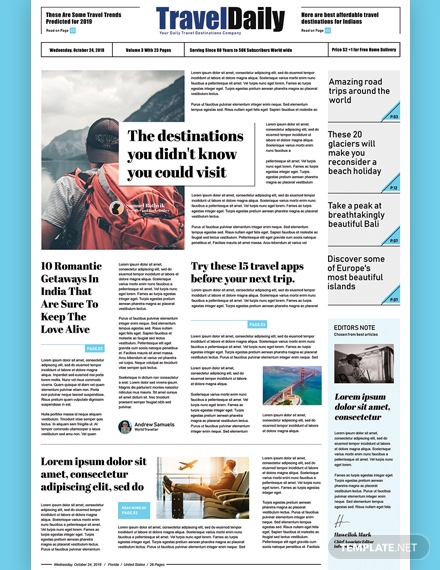
Art and Culture Newspaper
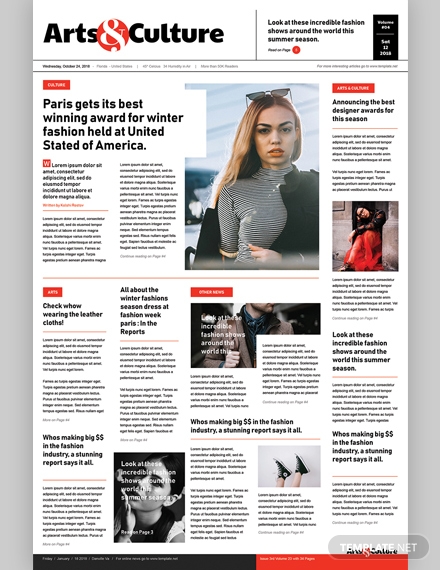
Automobile Newspaper
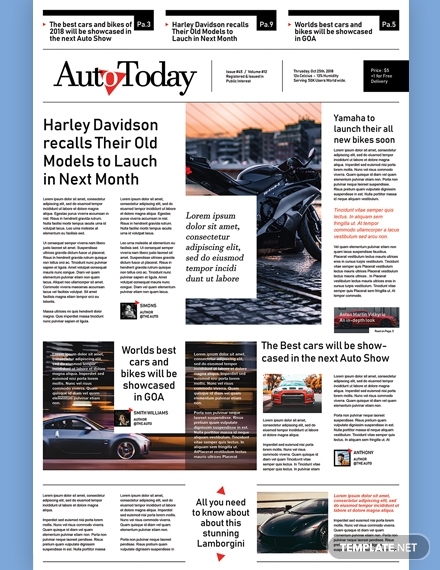
Financial Newspaper
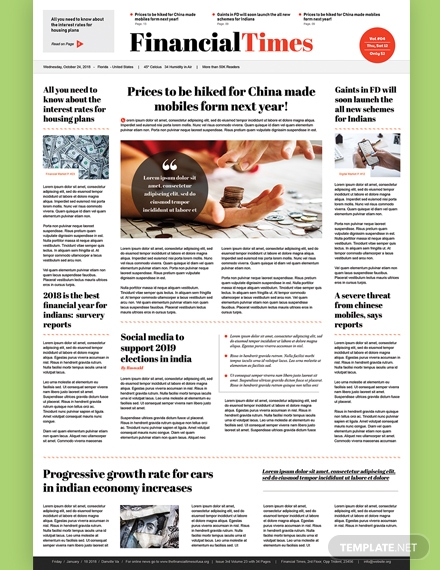
Food and Health Newspaper
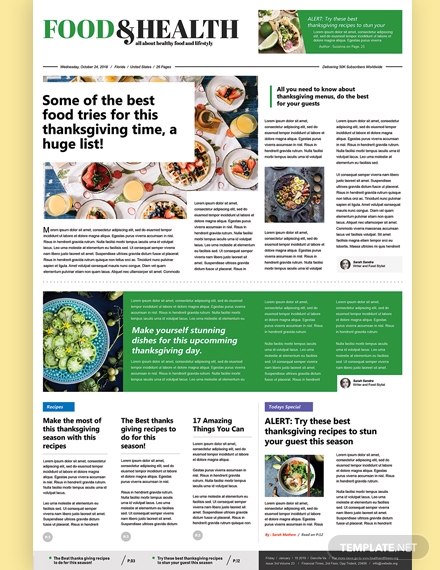
Health Newspaper
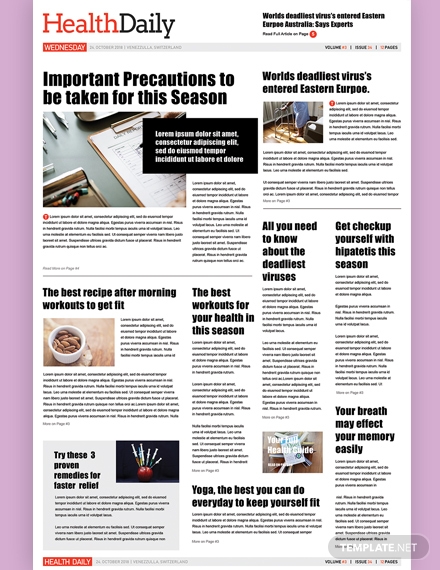
Interior Design Newspaper

Political Newspaper
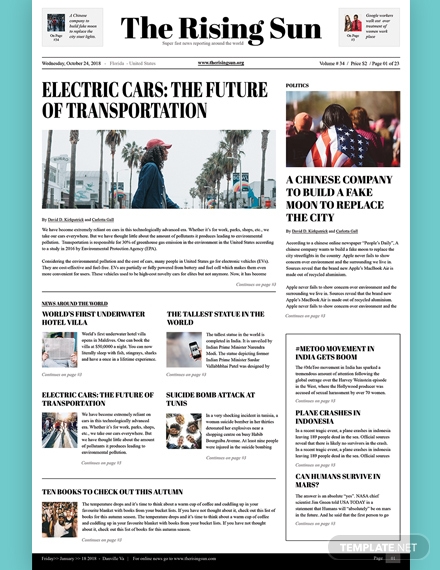
Real Estate Newspaper
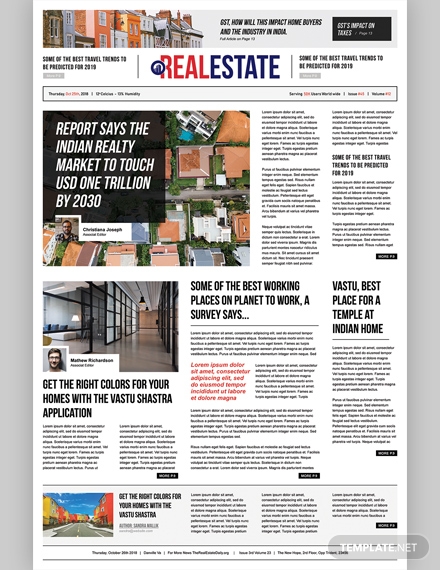
Religious Newspaper
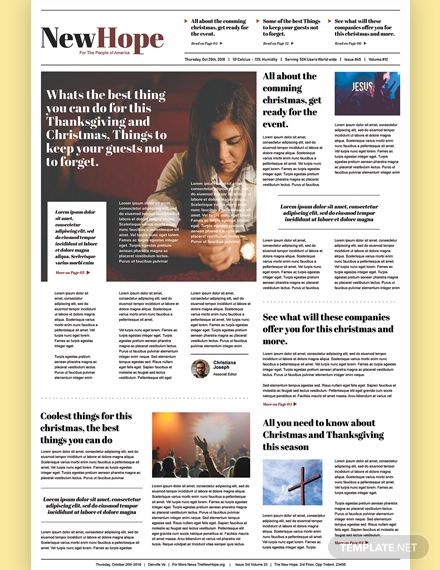
10+ Newspaper Layout Examples
Daily Mail
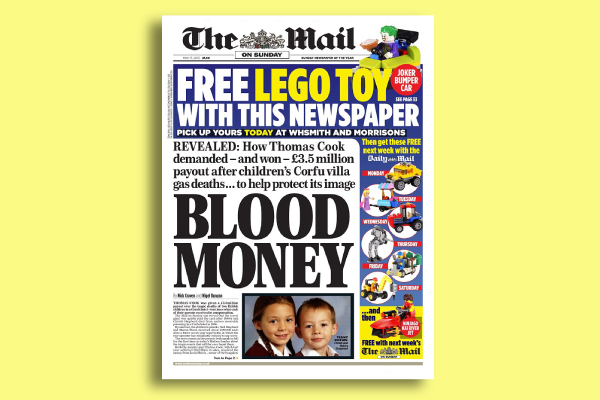
Daily Mirror
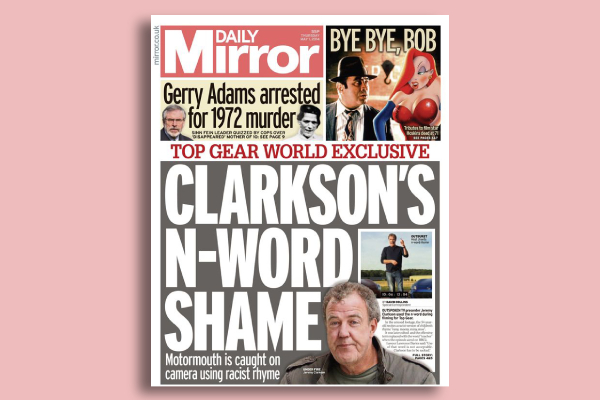
Irish Independent

New York Post

The Daily Telegraph
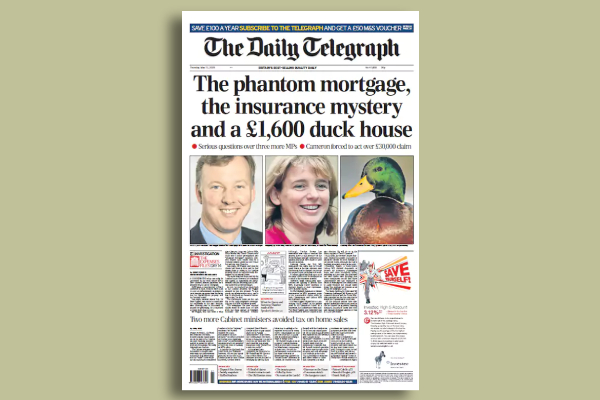
The Guardian
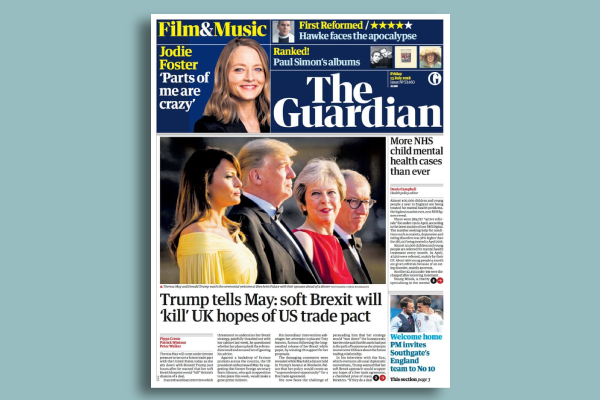
The New York Times

The Wall Street Journal

The Washington Post
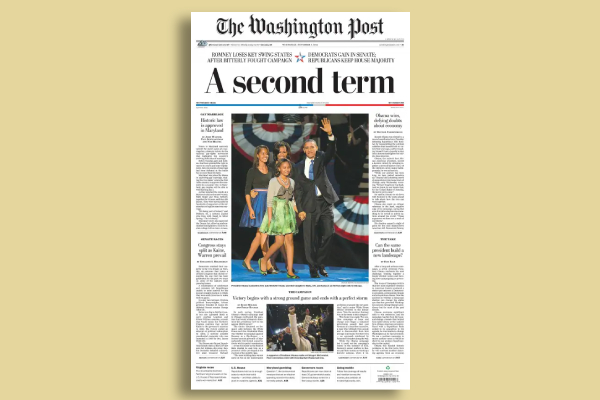
USA Today
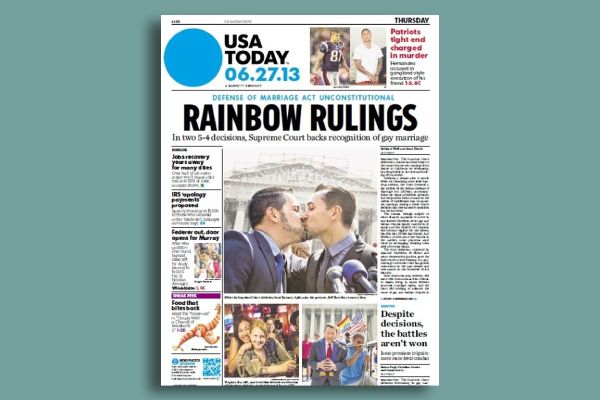
How to Make a Newspaper
Newspapers often vary in terms of complexity and sophistication. This usually depends on the purpose, content, and audience of your newspaper. However, there are some general instructions that may be applied to just about any type of newspaper there is.
1. Select a desktop publishing program: Lay out your newspaper on a desktop publishing program such as InDesign, Publisher, or Pages. This is where you can type your articles and design your overall layout. You can also find a number of these programs for free online.
2. Create the masthead: The masthead of your newspaper contains the name of the newspaper, date of publication, issue number, and other vital information. You may even include your Web address and company tagline to stay connected with your audience and reinforce your brand. It’s also best to use a maximum of two font styles for the content of your newspaper.
3. Include the most compelling articles on the front cover: The most timely and critical articles should have a place on the front page of your newspaper. This should be accompanied by solid, catchy headlines to pique one’s curiosity and encourage further reading.
4. Create columns and ad spaces: You’ll notice that the text elements of a news article are typically structured in columns. Creating four to five columns across each page will make it much easier to read as opposed to big blocks of text. Be sure to apply margins on all four sides so that your columns don’t run all the way down to the bottom of the page as well.
Additionally, remember to lay out the ads in appropriate locations. It should be in the size that advertisers purchased, without distracting readers from the main content of your newspaper. It’s also a good idea to position these ads in the most suitable sections of your newspaper to help complement each page.
5. Print your newspaper: For the final step of the process, you may be able to print the newspaper yourself. This would depend on the size and circulation of such publication, as production may require a significant amount of time and manpower to complete. Printing costs and product quality are two important factors to consider when producing a printed copy of your newspaper.
Tips for Designing a Newspaper
One of the most important things to remember when making a newspaper is to keep it simple and easy to read. There’s no point in getting too complicated with graphics when you’re only making it harder for people to read your articles. With that being said, here are few tips to keep in mind when designing a newspaper:
- Decide on a name: There’s something iconic about a newspaper’s name. It’s the one thing that people will remember even after they’ve read your articles. It’s important to choose a name that best suggests the nature of your business and the content produced. This greatly affects the way people perceive your newspaper as a professional publication.
- Keep pertinent business information visible: This is important for multiple reasons. Aside from making yourself accessible to potential advertisers, you’re also giving readers the chance to connect with you for whatever reason. In fact, many companies allow readers to contribute their own stories and creative pieces to feature in the newspaper. This helps builds the bridge between the publication and its audience. Thus, always remember to include your phone number, office address, and email address somewhere on top of the page.
- Indicate the issue near the top of the cover page: This can be something along the lines of “Issue Three” or “July Issue,” depending on your preference. This will make it easier for you and your readers to track and search for certain news articles whenever the situation calls for it. This can also keep your records properly organized for future reference.
- Create attention-grabbing headings and strong fonts: People often complain about how misleading some news headlines tend to be. But this is a clever strategy that most journalists and publishers use to highlight a story and generate more attention. You can easily blow a story out of proportion by mixing your words into something more interesting. Using bold fonts of a larger size must also be applied to separate news items and make them easier to find.
- Position advertisements properly: Some banner ads tend to distract readers from the central focus of your newspaper. This only makes it difficult for people to read the content that your editorial team spent hours making. Hence, make sure to strategize the placement of your advertisements accordingly. For instance, you can put your advertisements along the bottom of the page to keep it noticeable yet subtle.
- Pay attention to alignments: It might seem like a tedious job to carry out, but you’d be surprised by what a proper alignment can do to your layout. This includes the alignment of columns, pictures, titles, vertical and horizontal spacing, and image ratios.
- Go for a minimalist design: To avoid a cluttered layout, you must understand the concept of minimalism. Applying negative space and using images sparingly are just some of the ways to maintain a clean and readable content for your layout. Other than that, you should also select a good color scheme for your newspaper to help attract the eyes and reinforce your message.
Types of Newspapers
Listed below are the four major types of newspapers you’re likely to encounter:
- National Newspapers: Though the news coverage of a national newspaper may address international affairs, they mostly focus on news relating to specific areas around the country.
- Regional Newspapers: A regional newspaper offers detailed information about local news topics concerning citizens of a town, city, or group of villages. This includes announcements, events, and other celebrations that people of a particular region might be interested in.
- Local Newspapers: Along with international news, local newspapers also cover stories and events across the entire country. But since there’s a lot to cover in a limited amount of space, only major news articles are featured in each publication.
- Tabloid Newspapers: This is the largest, and arguably the most notorious, type of newspaper there is. This is the perfect news source for some of the juiciest headlines involving politicians, celebrities, and other famous personalities. It focuses on sensational news items that readers might be curious about, such as crime stories, celebrity gossip, and astrology. Though local and international affairs are usually reported in a serious manner, the information they deliver are sometimes questionable and controversial for some audiences.
Front Page Design & Layout
Gone are the days when newspaper covers were filled with chunks of headlines and topics from its content. These days, newspapers have taken the “less is more” approach to a whole other level by featuring two or four stories to lead the news and interconnect them to one another. This is done to capture a reader’s attention and have them pick it up.
There are two main formats of the front page. These are as follows:
1. Traditional: One good example of a traditional newspaper layout design is the front page of the New York Times. In spite of being a text-heavy publication, it uses photos, headlines, and text to deliver the top news of the day to readers. These are presented in a straightforward manner to give an audience exactly what they need in a single glance.
2. Progressive: Progressive newspapers combine texts, colors, photos, and infographics similar to that of a website layout. This adds an entertainment value that’s not only enticing to look at but irresistible enough to urge a desired response from readers. Its lavish style uses various forms of visuals to relay a message in such a way that readers can easily grasp.
Print Newspapers vs. Online Newspapers: The Pros and Cons
In this technology-driven era, the increasing popularity of online newspapers has made it difficult for the print newspaper industry to keep up. The declining interest in print editions is an alarming occurrence for many publishers, often forcing them to make budget cuts in staff and production.
But what is it about print newspapers that readers aren’t into anymore? What do online newspapers have that appeal to today’s audience? To answer these questions, let’s look into the benefits and drawbacks of both editions.
Print Newspapers
- Pros: It’s tangible. The feeling of a warm newspaper pressed against your fingers has the ability to awaken one’s senses. Apart from that, print newspapers can easily be saved or recycled for future use. Many individuals have a habit of keeping newspaper clippings in albums and scrapbooks, especially if the article covers a story that interests or concerns them. It’s an everlasting and unchanging publication that can be used and reused for a variety of purposes.
- Cons: It’s not free. Unless you’re at a restaurant or cafe that offers free newspapers to customers, every newspaper comes with a price tag. Not many people see the point of buying a print newspaper if they could easily get the same type of content from the Internet. This is a bad sign for many publishing companies, as a decline in circulation can potentially lead to a decline in advertising as well.
Online Newspapers
- Pros: It’s accessible and convenient. Not everyone has the time to take a look at the newspaper before they leave the house. Going to the store to buy one won’t make things easier, either. Thus, online newspapers offer a better alternative by bringing the news of the day to a reader’s mobile device or computer with a simple click of a button. You can even find the exact article of the story you’re looking for in just a matter of seconds.
- Cons: It’s incomplete. One notable disadvantage about online newspapers is how they are merely a shorter version of a print publication. That’s because it’s nearly impossible to post everything at once, considering how some stories tend to overshadow others. So if it’s a busy news day and a website is already overflowing with new content, companies are forced to leave out the smaller news items to make room for major affairs.
Newspaper FAQs
What is usually in a newspaper?
A newspaper is a periodical publication comprised of written information about a group of topics, such as current events, public announcements, and business advertisements. You can find a variety of stories covered from the fields of business, politics, sports, and entertainment. This is a useful communication tool that reports important information to people of a particular region. But because it’s impossible for a print newspaper to report news stories in a real-time basis, these are usually updated through the company’s online editions.
What is the importance of newspapers?
If your only source of information about current events is your Twitter timeline or Facebook news feed, then you need to think twice about the information you’re receiving. Although newspapers aren’t always a 100% right, you can’t deny the amount of research that journalists do just to cover a story. Generally, newspapers are a credible source of information about the latest happenings in our world. They can provide a great sense of educational value to readers regarding a country’s economic situation, sports, entertainment, games, trade, and commerce.
And there you have it! Deliver important information to an audience by making professional newspapers with the help of the newspaper layout templates and design ideas provided in this article.


